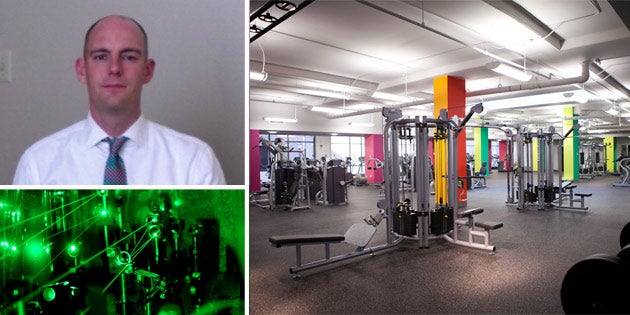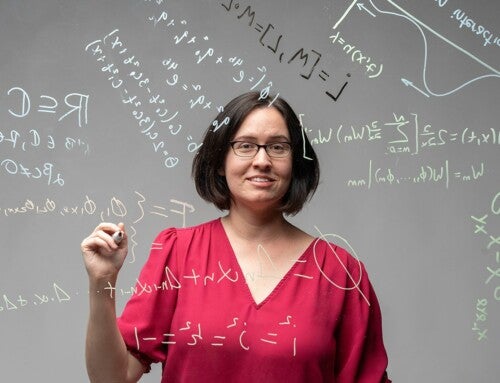
Professor Wes Dudgeon
Wes Dudgeon, professor of health and human performance, wears many hats. His students go on to allied health fields like medicine, nursing, dentistry and physical or occupational therapy, to research fields like biomechanics and exercise science, or to fitness careers like personal training and corporate wellness. Through his varied research projects and courses, Dudgeon aims to prepare students for any direction their public health, exercise science or athletic training degrees might take them.
WATCH: Wes Dudgeon explains why exercise science is one of the College’s fastest growing majors.
Find out about how Dudgeon’s career began with college basketball, an unexpected path to working at Google and why you might want to invest in a laser…
EXPLORE: Learn more about the College’s Department of Health and Human Performance
Q: How did you become interested in exercise science and public health?
A: I played basketball in college (Malone University in Ohio) so I always had an interest in sports and performance, then a good teacher turned me on to the science behind how the body adapts to physical tress, and that got me interested in physiology. When I got to graduate school and learned more about human performance, beyond just training athletes, I became more interested in research and academia.
Q: What kinds of research are you performing now?
A: I have a few research projects going on right now. One line of research that I’ve been working on for the past seven or eight years lexamines how people with HIV/AIDS respond to exercise training. So we draw blood to get a baseline for the subjects’ biomarkers and then have those folks train, and we study how exercise affects things such as their biochemistry, how it influences muscle and fat mass, how it affects their overall fitness. We’ve seen some positive results that show that regardless of the subject’s stage of HIV/AIDS, exercise is beneficial. We’ve also published findings that acupuncture, probably due to stress stress reduction, can help improve quality of life in people who have HIV/AIDS.
My other research falls into the human performance category. With the help of undergraduate students here at CofC, I test new equipment and products for manufacturers. We test it to see how these products impact fitness, study how many calories people burn when using them, and those kinds of things. The students really enjoy working on these projects because the practical application is easy to see.
Additionally, this spring I’m working with health and human performance professor Mike Flynn on a project that looks at the effects of training on immune function and inflammation in college students. A suspension training device called TRX, developed by Navy Seals as a way to train in the field without weights and other equipment, will be used as the training modality. We are going to look for changes in immune function and inflammation by analyzing blood samples taken before and after training with the TRX for 10 weeks. Research has shown decreased inflammation in older adults who become fit, so we are seeking to determine if the same holds true in a younger population.
Finally, some exercise science students and I are working with physics professor Linda Jones to examine the effects of a laser on muscle fatigue. We’re going to have students do a handgrip exercise while their forearm is exposed to a laser beam, obviously not one that would burn you. Lasers have been shown to affect some of the cells in the muscle, so we’re going to see if it affects fatigue. It’s a fascinating crossover between physics and physiology.
Q: How do lasers affect muscular cells?
A: The light frequency of the laser has been shown to penetrate and affect certain structure in the cell, specifically the mitochondria. The mitochondria is the powerhouse of the cell, it’s where most of our ATP is produced, and we believe that the lasers will stimulate the mitochondria to make more ATP and thus decrease muscle fatigue.
Q: What do your health and human performance students do after they graduate?
A: A lot of students go on to medical, nursing, dental, physical/occupational therapy or physicians assistant school. Students who are more interested in the research route go to graduate school for exercise science, exercise physiology, biomechanics, etc. Other students who are interested in the fitness aspect of the field get certifications from the American College of Sports Medicine and/or the National Strength and Conditioning Association and use those to work at gyms as personal trainers or at places like Boeing and Google focusing on corporate fitness.
Q: How can (and do) students use Charleston’s resources for fitness?
A: There are so many active things to do in Charleston just because of the location. It’s enjoyable to walk or run around downtown and look at the beautiful architecture, and walking at the beach is tough to beat as well. The water in and around Charleston offers the opportunity for Kayaking, standup paddle boarding, surfing. Charleston also has a lot of bike trails – you can practically ride from Isle of Palms all the way downtown, and pick up the greenway in West Ashley and ride to Johns Island.
Q: What is your favorite way to exercise?
A: I really enjoy high intensity interval training (HIIT) because it’s effective and fast; you can be done in 30 minutes. HIIT involves a lot of squats, dead lifts, and movements like that designed to increase your heart rate using large muscle groups. I have a young child, so I enjoy running because I can put her in a stroller and take her along. I do still like to play basketball but I’m not as as fast as I once was!
Q: What courses are you teaching this semester (spring 2015)?
A: I’m teaching Sports Nutrition, which our exercise science, athletic training and some public health students take, Exercise Physiology, which is a class for exercise science and athletic training majors, and I teach our Senior Seminar, which is a class designed to expose students to the most up to date research in the field while also assisting them in getting ready for life after college. We do this by helping them with resumes and cover letters and assisting them with the graduate school application processes.
Q: What is your educational background?
A: I got an undergraduate degree from Malone College in Ohio (now Malone University) in sports science, and then I got a Ph.D. in exercise physiology from the University of South Carolina.
Lasers image courtesy of Biolives.com.




